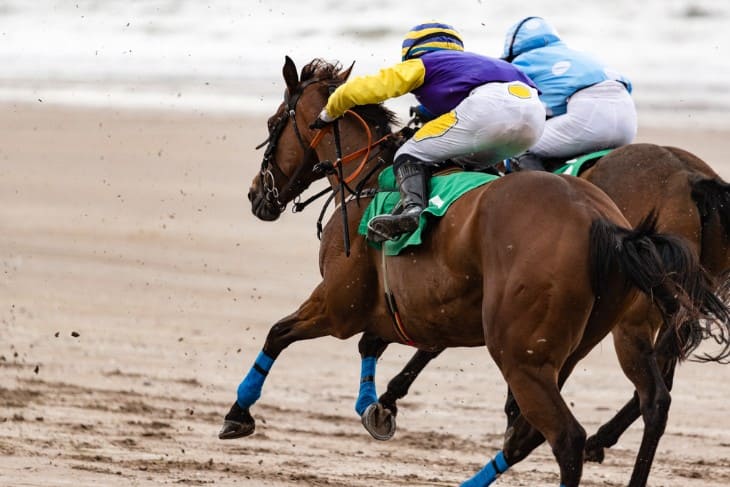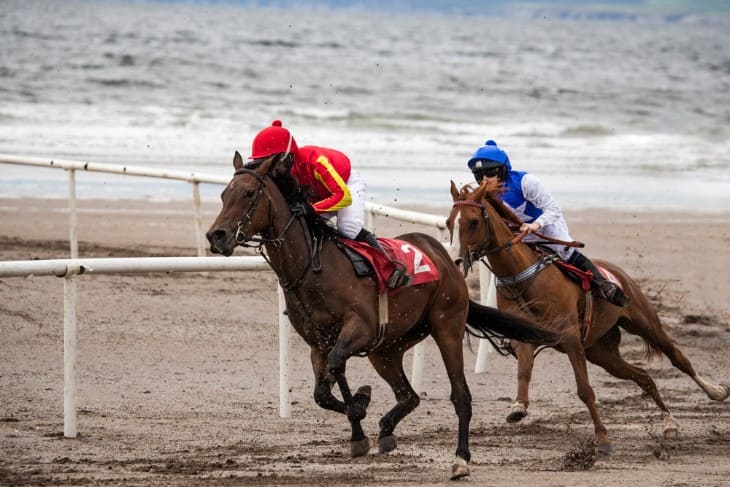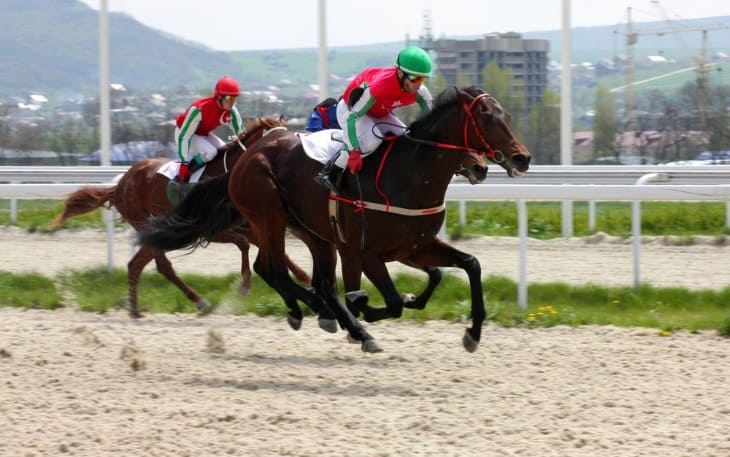As much as there are different breeds of horses that can run, horse races may vary in length. Horse racing encompasses different distances that vary from heart-stopping sprints to stamina-testing endurance. This is a comprehensive article on various types of race lengths within horse racing and their implications for the participants.
Understanding Horse Racing Distances
Horse races don’t come with a one-size-fits-all formula. The distance covered in a race can significantly affect how it is approached and what the outcome will be, so it matters to everyone involved, from trainers to bettors.
Sprints: The Speed Demons of the Track
Sprints in horse racing are an ultimate test of speed where the fastest horses on the track compete over short distances. They usually range between five and six furlongs with not even a second to spare. In sprint races, there’s no margin of error; oftentimes, the beginning itself counts as much as the finish does.
Speed demons, which maintain their speed and have explosive acceleration throughout any given race, are the most outstanding athletes here. Most times they are born this way making them stand out while trying to achieve high speeds. It is breathtaking for viewers whenever these animals leap from starting positions or thunder round courses.
For jockeys competing in sprints, tactics are plain but fierce. They need to reach prime position swiftly by snapping up chances across packs instantly thus opening an avenue towards the finish line. A few moments have gone by before strategies become apparent; therefore, the initial burst right out of the gates becomes instrumental towards win.
Also, many punters like sprinting events apart from jockey and horse lovers too because of their fast-paced nature which makes winning odds unpredictable and exciting at all times. Even though looking for boldness through past performances when contemplating wagers, sometimes unexpected individuals will explode into life within this group.
In conclusion, sprints are the speed demons of horse racing. It is a quick and furious competition that tests the speed and stamina of elite racehorses. They provide some of the most exciting moments in racing, captivating everyone involved be it jockeys, trainers or fans on their feet cheering from the stands.

Middle Distance Races: The Tactical Battles
Middle-distance races in horse racing combine elements of both speed and stamina to create some of the most tactical battles on track. They usually range between seven and twelve furlongs, which requires horses that can run at great pace without tiring easily even when being ridden strategically.
Although still crucial in these races, starting allows for more tactics than it does in sprinting. In such circumstances, riders should know when to hold back their runner and when it’s time to unleash him or her by making decisive moves as the closing stages approach. This calls for an understanding of one’s horse as well as rivals’ capabilities with due regard to race patterns.
A delicate balance is maintained between knowing one’s horse, understanding competition and watching a race unfold while staying alert during such events as this one.
Middle-distance races are where horses who appear to be good at anything can run fast, start well, run seamlessly in the middle and end strongly. They have to keep their energy for the critical time when they can release their bursts of speed. Not just physical strength, but also mind is required here as they obey instructions from jockeys and manoeuvre through among others.
For punters, this implies that middle-distance races provide a mix of elements such as the horse’s prior runs over different distances and the rider's skill in controlling speed. The tactical approach in these events leads to complexity within gambling which means it is preferred by those who like horse racing with its subtle strategies.
To sum up, middle-distance races epitomise the tactical essence of horseracing wherein elements of strategy combine with pace and stamina. It tests how good both horses and jockeys are at following plans into actions without any mistakes; this results in some most exciting and mentally challenging competitions in sport.
Long Distance Races: Stamina Checks
Long-distance races including steeplechases cover two miles or more than that which is considered to be the ultimate test of strength of the horse. These gruelling affairs require not only speed but also endurance, determination, and strategic pacing among other qualities from horses as well as riders involved. The aim then becomes maintaining a steady pace throughout while conserving enough energy reserves for a big finish.
Strategy changes significantly as the race gets longer compared to shorter distances. Hence after an explosive sprint start there will be careful positioning by jockeys so their horses can settle into comfortable running without getting tired too soon. This is about waiting till later since going too early may drain out a horse before reaching the final stretch.
Horses that perform well in long-distance races are known as stayers.” These animals are built and tempered for resilience because they can keep equal velocity across long stretch distances to spur powerfully at the last moment. Training for such runs emphasises stamina and resistance building.
For gamblers, long-distance races are quite different from the rest. It is important to forecast potential outcomes based on a horse’s proven staying power, jockey’s ability to control the pace, and even weather circumstances since some horses love certain atmospheres more than others. The unpredictability of these races with their changing dynamics and late bursts also adds excitement to betting.
In the context of thoroughbred racing, long-distance races exemplify both enduring physicality and the spirit within a racehorse. They are a mesmerising display of strategy, persistence and resolve wherein it is not only speed but resilience that separates a winner who can go the extra mile from others.
The Impact of Distance on Strategy
The length of a particular horse race greatly influences how jockeys and trainers manage their strategies. Every distance requires unique tactics based on an animal’s physical condition as well as mind state at this moment and situational features. Understanding that race length affects approaches will help one understand how complicated horse racing can be.
Sprints, for instance, are centred on speed. This is done by trying to reach the front as fast as possible immediately after the gates open and then maintaining a high velocity throughout the race. To avoid getting boxed in, jockeys work on putting their horses into an advantageous position allowing them to make an uninterrupted run at the finish line. Emphasises explosive power and acceleration.
Middle-distance races are marked by greater tactical intricacy. Here jockeys must strike a balance between speed and stamina, often restraining their horse in the early stages before making a decisive move as the race progresses. The strategy here is about timing and positioning which requires jockeys to be able to interpret what is happening in the race correctly so that they can decide when they should make their horse go forward.
Stamina and endurance become central issues in long-distance races. Initial pace matters less than in shorter events but more than this there is a need to economise energy for the final stretch. Careful pacing of horses has to stick within some limits where they still have enough left to fight for leadership over a few furlongs. Mental stamina becomes as important as physical endurance prompting composure all through.
Different strategies apply across different types of races depending on the distance covered by each one of them in horse racing. Thus, while sprints require maximum speeds, middle distances demand strategic pacing whereas longer routes call for total resistance among athletes concerned with winning gold medals in such events every time they compete. Knowing these subtle differences adds depth to horse racing’s drama and highlights how much skill and planning goes into it.
Varying Race Distances Between Events
Varying race distances across events underscore diversity within horse racing that plays up specific capabilities of different horses and imposes tactical restrictions on jockeys’ approaches towards riding these animals. This range ensures that through its dynamism; however, such facets have made horse racing a multifaceted sport.
- Classic Races: Classic races, such as the Derby or the Oaks, are usually run over middle distances of about 1 mile and four furlongs. Speed and stamina are both put to test in these prestigious events thus calling for a balanced approach by jockeys if they want to be winners. The nostalgic and traditional attachments that come with classic races like this just make them more interesting or exciting on top of being strategically challenging.
- Steeplechases: Steeplechases, including famous events such as the Grand National, typically take place over distances longer than 4 miles. They are jump races that add complexity to the race tactics. Jockeys have to negotiate these hurdles and maintain their horses’ stamina over long distances thus providing an exciting spectacle for the fans.
- Sprint Cups: Sprint cups are all about speed with races ranging from 5 to 6 furlongs. These events attract the fastest horses who rely on quick breaks and speed to win the race. Quickfire deciders and high-pressure situations make sprinting a fan favourite among adrenaline junkies.
- Endurance Races: Endurance races can cover more than fifty miles at their extreme distance range. These contests give more importance to pace rather than speed, with pacing being a key aspect of strategy along with knowledge of the horse’s staying power.
Horse racing is a sport of depth and variety as seen in different race distances across its various events. It is a representation of pure quickness in sprints compared to marathon runners’ unyielding energy; horse racing showcases the entire spectrum of equine athleticism, thus making every race a unique conundrum.

How Race Length Affects Betting Strategies
Punters consider how race length affects betting strategies when making informed decisions about their punts. Different bets go hand in glove with different distances thus creating conditions for players putting bets on them.
- Sprint Races: For punters in sprints, they may focus on horses that usually bolt out at the start or fast starters who use short acceleration bursts at the beginning points of their races. To better understand this type of betting strategy, it would be useful to look back at previous performances within shorter lengths or initial time comparisons after getting into action from paddocks before going further ahead in this chapter where your need will be explained clearly. Punters have fewer choices due to quick results hence the significance of an early dash.
- Middle Distance Races: In middle distance races, bettors will analyse several elements including stamina and the horse’s tactical abilities. Such a plan demands that one take into account horses that have demonstrated strength, and endurance as well as finishing strong. Bettors often examine past performances over similar distances and conditions, looking for patterns of strong finishes or strategic racing that could indicate a potential winner.
- Long Distance Races: Stamina becomes the overriding concern in long-distance races. Bettors look for horses with staying power to go the distance. Previous form in long races, pedigree information and training focus can all affect betting strategies. Punters may also consider the jockey's experience in managing pace over long distances, as strategic racing and energy conservation become crucial to securing a win.
Punters should understand how race length affects betting strategies to adjust their approaches accordingly depending on each race’s peculiarities. By considering the unique aspects of the sprint, middle-distance, and long-distance races, bettors can make more informed decisions, enhancing their chances of successful wagers.
Training for Different Distances: A Trainer's Perspective
Training horses for different distances needs a custom-made approach that reflects the varying demands of each race length on the horse. Understanding these specifications is critical for a trainer to get their horse ready for optimal performance in a sprint or long-distance race.
In sprint races, trainers aim to develop explosive speed and power. Usually, training programs consist of vigorous short sessions which build up muscular strength and improve the ability of a horse to swiftly break out from its starting position. Speedwork like practice runs over short distances at top speed helps to adjust the acceleration and quickness of the horse.
Middle-distance racing demands a compromise between speed and stamina by trainers who prepare horses for such competitions. Training includes longer runs that foster endurance coupled with enough speed work to ensure that the horse can maintain a competitive pace. The workouts aim at making sure that as he runs over an extensive racing period, his galloping capacity remains strong hence tactical mailing management.
For long races, however, they focus on developing remarkable stamina and endurance. Trainers lengthen the duration of training runs slowly so that horses can learn how to last longer periods with sustained effort involved in them. Recovery exercises also form part of conditioning which helps it withstand physical hardships during such long races even as strategies aimed at maintaining mental concentration and resilience are essential because, in reality, this animal has to stay focused throughout the entire race.
Training for various distances necessitates an intelligent mix of velocity, staying power and psychological readiness designed towards specific challenges associated with each race’s length. By understanding these requirements and addressing them accordingly, trainers can provide their horses with both desired physical attributes along with mental capabilities irrespective of any mileage they would be required to cover on D-Day.
In Summary
To conclude, there is no fixed answer about how long a horse race could be but then again every mile comes alive differently from another one due to unique characteristics presented by each distance covered by horses during competitions. From sprints that are over almost before they begin to gruelling ultramarathons, the length of a race is a fundamental aspect of horse racing strategy, training and betting approaches.
For paddock punters, understanding these distances and their implications can enhance the experience of the sport, making each race not just a test of speed or stamina, but a fascinating tactical battle played out on the track.







